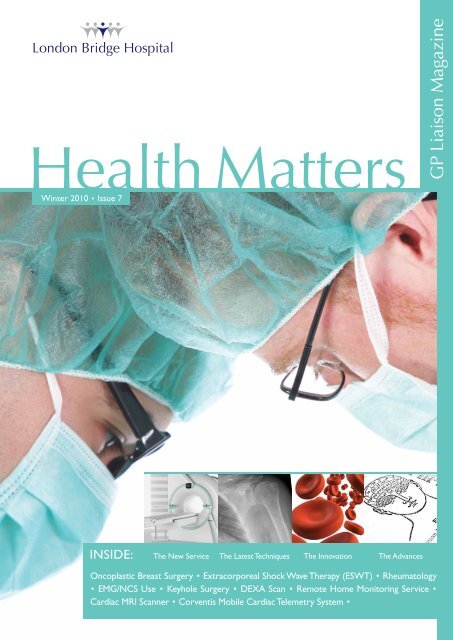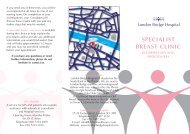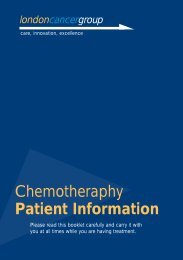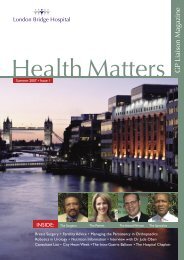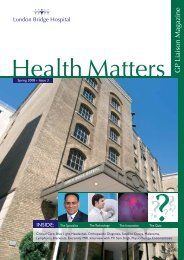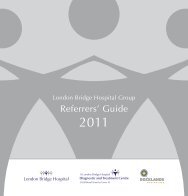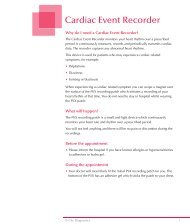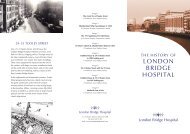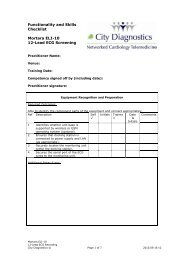Health Matters - London Bridge Hospital
Health Matters - London Bridge Hospital
Health Matters - London Bridge Hospital
- No tags were found...
Create successful ePaper yourself
Turn your PDF publications into a flip-book with our unique Google optimized e-Paper software.
<strong>Health</strong> <strong>Matters</strong>Winter 2010 • Issue 7GP Liaison MagazineINSIDE: The New Service The Latest Techniques The Innovation The AdvancesOncoplastic Breast Surgery • Extracorporeal Shock Wave Therapy (ESWT) • Rheumatology• EMG/NCS Use • Keyhole Surgery • DEXA Scan • Remote Home Monitoring Service •Cardiac MRI Scanner • Corventis Mobile Cardiac Telemetry System •
IntroductionA message from the CEOWelcome to the winter edition of <strong>Health</strong> <strong>Matters</strong> Magazine, our opportunity to present articles fromour Consultants at <strong>London</strong> <strong>Bridge</strong> <strong>Hospital</strong> and connect with you in terms of the services that we offerto support you and your patients.The fi rst thing that I would like to mention is the GP education programme which is going from strengthto strength, with good attendances at both our Saturday and Thursday evening GP seminar sessions.Our Saturday events in particular have proved immensely popular with over 180 attendees at ourDermatology Seminar in September 2010.Your feedback has specifi cally highlighted the expertise of our speakers, interesting topics and relevanceto primary care as the main reasons for attending. Our Practice Manager Forums are also provingsuccessful with the opportunity to network with fellow colleagues. We are also excited to be introducingpersonalised hospital tours which will be available upon request and will be tailored to the GP’s interests.Our GP Liaison Team is always available to help with any specifi c educational requirements and will behappy to hear from you.There may be many services at the hospital that you are not aware of. For instance, the Dialysis Unitat <strong>London</strong> <strong>Bridge</strong> <strong>Hospital</strong> has been providing quality Dialysis to both NHS and holiday patients forover 20 years. Our Dialysis Consultant has a worldwide reputation and our recently refurbished unitoffers patients high quality care within easy reach of the City.These and many other services have stood the test of time. The key selling point for <strong>London</strong> <strong>Bridge</strong><strong>Hospital</strong> is the quality of its Consultants. We are located very close to some very eminent teaching <strong>Hospital</strong>Trusts and I am delighted to say we are able to apply the same strict level of clinical governance and auditwhich you might expect to fi nd in a postgraduate medical facility. This environment allows our specialiststo feel comfortable that their standards are not in any way compromised and that they can develop theirpractices in partnership with us.The quality of our relationship with you and that of our referring GPs allow us to respond quickly tofeedback in order to meet your requirements and this is reflected in the membership of our MedicalAdvisory Committee, which includes two GPs. Myself and all our staff, including Ward Managers and GPLiaison Teams have ample time and opportunity to spend with our referrers to understand their needsso that we can deliver better quality services for our patients.I wish to thank you very much indeed for your continuing involvementin the hospital, for the feedback you provide us and for the opportunityto care for your patients. I hope very much that you will continue tovisit the hospital, attend our events and to regard us as partners in yourpatient’s care. Please continue to feedback to me and to the GP LiaisonTeam wherever you see an opportunity for us to extend our partnershipwith you or indeed to improve what we offer. Please enjoy this magazineand thank you as always.With kind regards and best wishes.Yours sincerelyJohn ReayChief Executive OfficerJohn ReayChief Executive OfficerTWOIntroduction
FeaturesFeaturesp4 Oncoplastic Breast Surgery6 Extracorporeal Shock Wave Therapy (ESWT)For sports injury treatment8 10 Minutes With...Interview with Mr Simon Owen-Johnstone, Consultant Orthopaedic Surgeon9 Ten Topics in Rheumatology10 EMG/NCS Use in Primary Care11 Keyhole SurgeryFor fractures around the shoulder12 Remote Home Monitoring Service13 Imaging Services DepartmentIntroducing the DEXA Scan to <strong>London</strong> <strong>Bridge</strong> <strong>Hospital</strong>15 <strong>London</strong> <strong>Bridge</strong> <strong>Hospital</strong>’s Dialysis Unit Relocated15 Introducing <strong>London</strong> <strong>Bridge</strong> <strong>Hospital</strong>’s Online Registration Portal16 Corventis Mobile Cardiac Telemetry System16 New Cardiac MRI Scanner17 Innovation Aids Recovery<strong>London</strong> <strong>Bridge</strong> <strong>Hospital</strong> avoids blood transfusion and aids patients’ recovery17 Endoscopy and Gastroenterology at <strong>London</strong> <strong>Bridge</strong> <strong>Hospital</strong>18 <strong>London</strong> <strong>Bridge</strong> <strong>Hospital</strong> Refurbishment on Track19 GP Liaison Team20 New Consultant ListGP Liaison DepartmentTel: 020 7234 2009Email: gpliaisonlbh@hcahealthcare.co.ukDISCLAIMER NOTICEAny publication included in <strong>Health</strong> <strong>Matters</strong> and/or opinions expressed therein do not necessarily reflect the views of HCAInternational Limited (including <strong>London</strong> <strong>Bridge</strong> <strong>Hospital</strong>) (‘HCA’) but remain solely those of the author(s). The author(s)have used reasonable endeavours in preparing this publication. However, the author(s) make no representation or warrantywith respect to the accuracy, or completeness of the contents of this publication and specifi cally disclaim any impliedwarranties or fi tness for a particular use. All of the information supplied in this publication is published without warranty, itdoes not constitute legal or any other professional advice and the reader must satisfy themselves to its suitability for use.The information contained in this publication is the exclusive property of HCA or is licensed to HCA and is protected bycopyright and/or other proprietary rights. This information includes but is not limited to the design, layout, look and feel,appearance and graphics. Nothing contained in this publication may be reproduced, distributed or edited in any mannerwithout the prior written authorisation of HCA.FeaturesTHREE
t SurgeryMr Anil J DesaiConsultant OncoplasticSurgeonSecretary: Maria ParkerT: 020 7234 2246F: 020 7234 2998maria.parker@hcahealthcare.co.ukwww.breastcancersurgeon.uk.comOncoplastic Breast SurgeryFig. 1Patient 1: Had a large tumourin the upper inner part of rightbreast. Underwent chemotherapyto shrink it down, becameimpalpable, wire localised forsurgery. Image shows postchemotherapy,pre-op.Fig. 2 & Fig. 3Patient 1: 10 days after surgery –cancer removed and both breastsuplifted.Fig. 4Patient 1: Three years after surgery.Fig. 5Patient 2: Had a tumour removedfrom right breast using breastreduction technique (therapeuticmammaplasty) and simultaneousleft breast reduction.Fig. 6Patient 3: A recent case – tumourremoved from left breast bybreast reduction techniqueand simultaneous right breastreduction mammaplasty.Fig. 5 Fig. 6Mr Anil J Desai is a ConsultantSurgeon with a special interest inOncoplastic and ReconstructiveBreast Surgery and AestheticSurgery of the Breast.Mr Desai possesses 11 yearsof experience as a ConsultantBreast Surgeon and hascarried out over 300 breastreconstructions using implants,LD fl aps, LD fl aps with implantand TRAM fl aps. He possessesextensive experience in breastenlargement, reduction and uplift.Mr Desai completed trainingat Charing Cross <strong>Hospital</strong> asa Senior Registrar. He trainedin the North Thames regionacquiring over seven years ofbreast experience and obtainedan MPhil in Molecular Biologyat the University of <strong>London</strong>.He enriched his experience byvisiting various internationallyacclaimed breast units andregularly attending conferenceson breast cancer, oncoplastic andreconstructive breast surgeryand cosmetic surgery of thebreast. He has a busy NHSpractice in South East <strong>London</strong>and is the lead surgeon at‘Quality Assurance for <strong>London</strong>’for breast screening.Mr Desai passionately believesthat no breast cancer patientneed bear a visible scar ofsurgery on the breast. He is nowavailable to consult at <strong>London</strong><strong>Bridge</strong> <strong>Hospital</strong>.Oncoplastic Breast SurgeryFIVE
Extracorporeal Shock Wave TherapyExtracorporeal ShockWave Therapy (ESWT) forSports Injury Treatmentby Dr Stephen Motto, Sports Injury DiagnosticsWhat is Extracorporeal ShockWave Therapy (ESWT)?Extracorporeal Shock Wave Therapy(ESWT) is a relatively new techniquethat uses shockwaves to treat chronicconditions of the musculoskeletal system.I have been using ESWT for nine years.It is the same technology used to treatpatients with kidney stones in the 1980swithout surgery (Lithotripsy). Thistreatment was subsequently applied to avariety of musculoskeletal conditions andthe technology was refined in the 1990s.I use a device called orthoPACE fromthe Pulsed Acoustic Cellular Expression(PACE) platform. This device generateselectrohydraulic shock waves thathave a biological activating effectwhich regenerates hard and softmusculoskeletal tissues such as bone,tendons and ligaments.orthoPACE utilises medium to highenergy acoustic or pressure waves tofocus treatment for tendinopathies,chronic bursitis, some cases of tibialperiostitis (‘shin splints’) and may helpwith delayed bone healing. The PACEprinciple involves the induction of cellularsignals and factors including increasedangiogenesis that promote healing inwounds and soft tissues.We are trying to convert a chronic injuryinto an acute one by mechanotransduction,working synergistically with exercisetherapy. It also complements otherenergy treatments provided, such asLaser needle, Pulsed Electromagnetictherapy and InterX (a sensory electricalneuro-stimulation device).What happens during ESWT?Treatment is carried out in the SportsInjury Diagnosis clinic at <strong>London</strong> <strong>Bridge</strong><strong>Hospital</strong> and takes about 20-30 minutes.The patient is usually able to return towork but should restrict activities duringthe first week. Follow-up examinationand treatment take place at four-sixweeks, although further treatment maynot be necessary. Treatment may not becovered by medical insurers.Many patients experience an improvementin symptoms almost immediately, whileothers take two-three weeks to respond.A few fail to respond with 10% or soexperiencing a transient aggravation.There may be a transient reddening orswelling of the area with some patientsexperiencing a brief increase in pain.Numbness or paraesthesia are lessfrequent side effects.Patient experiencesI recently presented some of myexperiences using shockwave therapyat the 2nd Congress of the EuropeanCollege of Sports and Exercise Physicians,9th-11th September 2010, at QueenMary, University of <strong>London</strong>.It is accepted that managing chronicpatella tendinopathy (‘Jumper’s knee‘),prevalent in 7%-40% of the athleticpopulation, is difficult with athletesexperiencing frequent setbacks andrecurrent pain and dysfunction formany months. Two papers have foundshockwave therapy to be of somesuccess (see References 1 and 2) for thiscondition, whereas in my hands the mostsuccessful areas are in the treatmentof plantar fasciitis, insertional Achillestendinopathy, calcific tendinopathy of theshoulder, quadriceps tendinopathy andonly of marginal benefit in tennis elbow.I hope the introduction of orthoPACE willaddress some of the shortcomings of itspredecessor (EvoTron). First impressionsare that it is less painful for the patient,who seems better able to toleratetreatment with the new device withoutlocal anaesthetics. The new applicatorfor orthoPACE delivers higher energydensities at more superficial depths. Thehope is that conditions such as patellatendinopathy and tennis elbow willrespond more favourably than with theEvoTron.A couple of successful applicationsof ESWT at Sports InjuryDiagnosis clinic:• A walker with a heel spur and aone-year history of heel pain.• A lady with Addison’s diseaseand chronic Achilles tendinopathypreventing her from working.Dr Stephen MottoBM Dip Sports MedD M-S Med Dip Med AcFFSEM (Ireland) FFSEM (UK)Sports &Musculoskeletal ConsultantDr Stephen Motto is a Sports& Musculoskeletal Consultantat Sports Injury Diagnosis, asports medicine clinic based atSt Olaf House in <strong>London</strong> <strong>Bridge</strong><strong>Hospital</strong>, with an additional clinicat 31 Old Broad Street.For further details aboutSports Injury Diagnosis, contactMrs Anne Sampson, PracticeManager, on:T: 020 7403 0330orthoPACE is one of a number oftreatments offered by Sports InjuryDiagnosis clinic at <strong>London</strong> <strong>Bridge</strong><strong>Hospital</strong>. I assure you that whilst thereis no danger of me swimming thechannel, or running in the <strong>London</strong>Marathon, I am committed to helpingelite and recreational athletes/patientsachieve their exercise and sporting goals.References1. Extracorporeal Shock Wave Therapy for patellar tendinopathy: a review of the literature. van Leeuwen, Zwerver, van den Akker-Scheek. BrJSportsMed 2009;43:163-1682. Extracorporeal Shock Wave for Chronic Patellar Tendinopathy. Wang et al. Am J Sports Med June 2007; 35: 972-978SIXExtracorporeal Shock Wave Therapy
Unparalleledpremiumhealthcareserviceson yourdoorstepDocklands <strong>Health</strong>careDesigned to meet the fast-paced demands ofthe Canary Wharf and Docklands community,Docklands <strong>Health</strong>care offers an unparalleledrange of premium diagnostic imaging servicesand healthcare.Our imaging centre offers a convenient locationand minimal waiting times so any medicalconcern can be swiftly addressed and thehighest quality treatment offered.Docklands <strong>Health</strong>care is conveniently located on theground floor of the Clifford Chance Building, Upper BankStreet, next to Canary Wharf tube station (east exit).Diagnostic ImagingWe have a team of fully qualified and experienced radiographerson hand with results assessed by leading consultants from<strong>London</strong>’s top hospitals. Diagnostic imaging services include:• General X-ray• MRI scanning• Ultrasound scanningOrthopaedicsOur team of orthopaedic consultants specialise in the following:• Arthritis• Cartilage repair/replacement• Cartilage tears inside a joint• High performance hip and knee replacements• Management of ligament tears• Surgical ligament reconstruction• TendonitisIf onward referral is required, <strong>London</strong> <strong>Bridge</strong> <strong>Hospital</strong> ensuresconvenient access to consultants from a wide range of otherspecialties.For further information on Docklands <strong>Health</strong>careplease call 0844 800 0636or visit www.docklandshealthcare.comDocklands <strong>Health</strong>care is an outpatient diagnostic centrein affiliation with <strong>London</strong> <strong>Bridge</strong> <strong>Hospital</strong>.
10 Minutes With...10 minuteswith...Mr SimonOwen-JohnstoneConsultant OrthopaedicSurgeonMr Simon Owen-Johnstone, Consultant Orthopaedic Surgeon1. Why did you decide to studymedicine?Medicine is a fascinating blend of artand science. It’s highly technical andthere is a lot of human interaction.2. What made you pursue yourspecialty?Shoulders, elbows, wrists and handsoffer the challenge of complexproblems and elegant surgery.3. What is the most rewardingpart of your job?Undoubtedly it’s making people better.It’s a privilege to be able to take aperson in discomfort or disability, workout why, correct the problem with orwithout an operation, and see themrecover to get a part of their life back.4. What do you enjoy doing inyour spare time?My wife and I make the most of livingin <strong>London</strong>; dining out, theatre, dance,galleries, music, museums, culture,architecture, even shopping.5. What is the title of your bestread so far?It is difficult to choose: Zadie Smith’s‘White Teeth’ is beautifully written,but Dickens’ ‘A Tale of Two Cities’captures Victorian <strong>London</strong> lifebrilliantly.6. If you could invite three peopleto dinner, living or dead, whowould they be?David Dimbleby for his current affairsknowledge, my favourite comedian,Dara O’Briain, and John Reay, <strong>London</strong><strong>Bridge</strong>’s superb Chief ExecutiveOfficer.7. What is special about whereyou grew up?Absolutely nothing: Leicester!8. Where is your favourite placein the world?The British Virgin Islands, on a yachtwith my family, but Dartmouth is aclose second.9. Who would you get to playyourself in a movie?Well, I thought George Clooney wasa good match, but my kids voted forRik Mayall...Mr Simon Owen-Johnstonespecialises in problems affectingshoulders, elbows, wrists andhands, known collectively asthe Upper Limb. Mr Owen-Johnstone’s NHS practice isat St Bartholomew’s <strong>Hospital</strong>and The Royal <strong>London</strong>, one ofthe four Trusts in the <strong>London</strong>Trauma Network, wherehe is the Lead Clinician forTrauma & Orthopaedics. MrOwen-Johnstone teaches onpostgraduate courses at theRoyal National Orthopaedic<strong>Hospital</strong>, the Royal Collegeof Surgeons and the RoyalSociety of Medicine. Helectures regularly at GP andPhysiotherapy events through<strong>London</strong> <strong>Bridge</strong> <strong>Hospital</strong>.Mr Owen-Johnstone can becontacted via GP Liaison at<strong>London</strong> <strong>Bridge</strong> <strong>Hospital</strong>:T: 020 7234 2009or through his secretary,Sangeeta, on:T: 07949 782339medicalsec@hotmail.comEIGHT10 Minutes With...
If you are interested inattending next year’s ‘Ten Topicsin Rheumatology’ meetingor if you would like moreinformation on rheumatology orlupus, please contact the <strong>London</strong>Lupus Centre at <strong>London</strong> <strong>Bridge</strong><strong>Hospital</strong> on:T: 020 7234 2155RheumatologyProf Graham Hughes<strong>London</strong> Lupus Centrewww.tentopics.comTen Topics inRheumatologyProfessor Graham Hughestrained and qualified at The<strong>London</strong> <strong>Hospital</strong>. In 1969,Professor Hughes moved toNew York, spending two yearsdoing a Postgraduate Fellowshipat the Rheumatology & LupusCentre of Dr Charles Christian.Professor Hughes becamea Consultant Physician atHammersmith <strong>Hospital</strong>where he set up Europe’sfirst dedicated Lupus Clinic in1973. In 1983, he described theclotting disorder now knownas Hughes Syndrome. In 1985,he set up the Lupus Unit at StThomas’ <strong>Hospital</strong>.In 1993, Professor Hughesreceived the WorldRheumatology (ILAR) ResearchPrize for the description ofHughes Syndrome. He is alsoa member of the AmericanLupus ‘Hall of Fame’, andDoctor Honoris Causa at theUniversities of Marseille andBarcelona.<strong>London</strong> <strong>Bridge</strong> <strong>Hospital</strong> is a keysponsor of the annual ‘Ten Topics inRheumatology’ postgraduate meeting.Held at St Thomas’ <strong>Hospital</strong>, the two-dayevent is organised by Professor GrahamHughes and Sandy Hampson from the<strong>London</strong> Lupus Centre at <strong>London</strong> <strong>Bridge</strong><strong>Hospital</strong>.The event has become one of the mostsought-after postgraduate meetings ofthe academic calendar and is always fullysubscribed.This year, <strong>London</strong> <strong>Bridge</strong> <strong>Hospital</strong>and St Thomas’ team were joined byguest lecturers from around the world,including Professor Frederic Houssiau(Belgium), Dr Claudia Fofi (Italy), DrSteve Binder (USA) and Professor ARosen (USA). Topics included new drugsin lupus, the gut and arthritis, advancesin osteoporosis and clinical featuresof the antiphospholipid (Hughes)syndrome.Guest speakers Dr Richard Horton,Editor of Lancet, and Dr Ed Coats, whoby Professor Graham Hughesmade a televised trip to the South Polewith Ben Fogle and James Cracknell,gave interesting and highly entertainingtalks.Presentations were given by leadersin the rheumatology field, with topicsalternating between the highly ‘clinical’and more ‘basic science’ topics.The annual feature, Nightmare onLambeth Palace Road (the streetaddress for St Thomas’ <strong>Hospital</strong>),featuring difficult cases for generaldiscussion proved very popular.Such has been the success of ‘TenTopics’ that satellite meetings arenow held in Barcelona, Rome, Nice,Buenos Aires and Asia – this year inSingapore.Next year marks the 25th Anniversaryof the <strong>London</strong> Ten Topics and will beheld on 30th June and 1st July 2011.Mark the dates!RheumatologyNINE
EMG/NCS UseDr Alistair PurvesConsultant ClinicalNeurophysiologistEMG/NCS Usein Primary Careby Dr Alistair PurvesMost GPs will be aware of the existence of departments of ClinicalNeurophysiology in their local hospitals, but historically not many have had directaccess. In my NHS practice at King’s College <strong>Hospital</strong> I have had open access toGPs for some years – currently about 15-25% of my referrals are direct. I findthat the patients coming to us directly are essentially the same as those comingfrom orthopaedics etc, and the rising proportion of GP referrals suggests thatthose who refer are finding it a valuable diagnostic tool.Electromyogram and Nerve Conduction Studies (EMG/NCS) are concernedwith techniques looking directly at peripheral nerve and muscle function viatheir electrical properties. We can characterise nerve damage or compressionproblems, and can indicate the site of this as well as the severity. This is wellestablished for many of the common entrapment neuropathies such as CTS orulnar compression.A new and important area exists in EMG/NCS where patients who present withsymptoms that appear to be neurological like tingling, numbness, pain, clumsinessor weakness in an arm or leg, but where the distribution does not conform toa standard pattern. A typical patient might have pins and needles throughout anarm, weakness or unreliability of grip and poorly localised proximal pain. Spinalimaging often fails to show any abnormality beyond some degenerative changeappropriate to occupation and age.Due to the very neurological flavour of the symptoms there often remainsconcern that there is nerve damage somewhere, and it is very helpful clinicallyto demonstrate that there is no nerve compression or damage either in theperipheral nerves, or in the brachial plexus or in the cervical roots. We oftenfind that patients who have neck and shoulder pain and who have some othercoexisting condition such as carpal tunnel syndrome (CTS), display atypicalsymptoms, e.g. the sensory symptoms are often in the entire hand or even in the‘ulnar’ fingers. We can show the separate components of a mixed picture that canbe clinically very confusing.Dr Purves qualified at Cambridgein 1981, and trained atAddenbrookes <strong>Hospital</strong> andthe National <strong>Hospital</strong> forNeurology and Neurosurgery.He is a Consultant at King’sCollege <strong>Hospital</strong> and providesan extensive service in EMGand conduction studies thereand in Kent. He has a particularinterest in the neurophysiologyof pain syndromes.For more information on EMGand NCS or to contact DrPurves’ secretary, please phone:T: 01622 620910Some patients with what wouldotherwise be called a pure painsyndrome, such as fibromyalgia, doalso have neurological symptoms,and neurophysiology is veryuseful for reassuring patientsand doctors that there is nounderlying nerve damage. If thereis an abnormality, this then allowsan appropriate further referral tobe made – to rheumatology or apain specialist, or to orthopaedicsif there is a peripheral lesion suchas a CTS, or to neurosurgery, ifthere is evidence of cervical orlumbar root lesions.TENEMG/NCS Use
Keyhole Surgery forFractures Aroundthe ShoulderFractures around the shoulder are usuallydue to high energy impacts like thoseoften seen in contact sporting injuries.These usually result in either a fracture ofthe proximal humerus or of the glenoidprocess of the scapula. Such fractures arenotorious for poor outcomes and longperiods of rehabilitation and often requirelarge open operations to fix the fractures.The latest techniques involve usingkeyhole surgery (shoulder arthroscopy)to assist in debriding the fracturefragments and under direct visualisation,accurately reduce the fracture back toan anatomical position. The advantagesof these techniques are that mostprocedures can be performed viaminimally invasive techniques with areduced risk of infection, a faster recoveryrate and a better long-term outcome.By remaining at the forefront of thelatest techniques and ensuring bestpractice, Mr Kochhar has developed ahigh quality and efficient shoulder servicefor sports injuries and fractures, as well asdegenerative conditions of the shoulderand upper limb.Case study 1A 38-year-old gentleman fell over ontohis right shoulder whilst skiing. Thepre-operative CT scan demonstratesa fracture of the anterior part of theglenoid:by Tony KochharFig. 1 – Pre-op CTFig. 2 – Pre-fixation viewVia arthroscopy of his shoulder, the fracturefragment was debrided and reducedaccurately and then via a mini open incisionfrom the front of the shoulder, a screw wasplaced retrograde (from front to back),securely fixing the fragment back onto therest of the glenoid fossa.Fig. 3 – Retrograde screwThe fixation was solid and there wasan accurate reduction. The patientwas mobilised almost immediately. Hereturned to a pre-operative level offunction within eight weeks. He hasreturned to full sporting activities.Case study 2Fig. 4A 44-year-old man was rugby-tackled andsustained a minimally displaced impactionfracture of the greater tuberosity.Fig. 5He underwent an arthroscopy of hisshoulder and under direct arthroscopicvisualisation the fracture was debrided.Fig. 6The fracture was securely fixed using twosuture anchors. These sutures were passedthrough the fragments to result in a solidsuture repair of this fracture.Tony KochharConsultant Shoulder &Upper Limb SurgeonTony Kochhar is a ConsultantOrthopaedic Surgeon here at<strong>London</strong> <strong>Bridge</strong> <strong>Hospital</strong>. Heis an expert in surgery of theshoulder, elbow, wrist and hand.He completed his training atthe Royal National Orthopaedic<strong>Hospital</strong> in <strong>London</strong>. He hasfurthered his shoulder and upperlimb training by working withsome of the best surgeons in theworld, having completed specialistfellowships at worldwide centresof excellence in New York andthe world-renowned Alps SurgeryInstitute in Annecy, France.By remaining at the forefrontof the latest techniques andensuring best practice, MrKochhar has developed a highquality and efficient shoulderservice for sports injuries andfractures as well as degenerativeconditions of the shoulder andupper limb. Mr Kochhar regularlylectures on shoulder and upperlimb surgery at national andinternational conferences andtraining courses.Keyhole SurgeryFig. 1Fig. 2Fig. 3He has regular outpatient clinicsessions here at <strong>London</strong> <strong>Bridge</strong><strong>Hospital</strong> on Tuesdays and Fridays(both daytimes and evenings).To make an appointment to seeMr Kochhar, please contact theGP liaison department at <strong>London</strong><strong>Bridge</strong> <strong>Hospital</strong>, or his secretaryon:T: 020 3301 3750Fig. 4Fig. 5Fig. 6Further information is availableon Mr Kochhar’s website:www.shoulderdoctor.co.ukKeyhole SurgeryELEVEN
Remote Home MonitoringRemote HomeMonitoring Serviceat <strong>London</strong> <strong>Bridge</strong><strong>Hospital</strong>How does thepatient benefit?• Remote follow-up providesvaluable clinical informationthat cannot normally beobtained until the nextscheduled clinic visit• It can potentially reduceinappropriate therapy• Earlier pharmacologicalintervention• Increased peace of mindand the assurance thattheir Consultant and GPcan monitor specifi c deviceinformation continuously• Individually tailoredcomprehensive cardiac care,promoting early detection,notifi cation and interventionof any potential cardiacdevice related problemsRemote monitoring has recentlybeen introduced to the CardiologyDepartment at <strong>London</strong> <strong>Bridge</strong> <strong>Hospital</strong>with great success. Home monitoringis a fairly new initiative introduced forpatients with implantable devices, such asa pacemaker or defi brillator. It providesa unique way to collect and downloaddiagnostic data from an implantabledevice while the patient remains in thecomfort of their own home. This enablesthe physician and GP to obtain nearlythe same information as a hospital clinicvisit, with just a few exceptions.So how does it work?The system is able to function with asmall piece of equipment, roughly thesize of a home telephone. All the patientneeds is a power cord and telephonelandline to connect. The patients aregiven a full demonstration and educationsession in the clinic before taking thecommunicator home. The device sits in aconvenient place in the home, usually ona bedside table and is able to downloaddevice information and send it securelyvia the internet. This information is thenaccessed by a Cardiac Pacing Physiologistwho interprets the results and producesa report for the Consultant.How often is informationdownloaded?The frequency of the informationdownloads is decided by the Consultantdepending on the nature of the patient’sdevice and medical history. For example,a pacemaker patient is usually seen inclinic once a year. With home monitoringa Consultant may decide they would likea download once every three monthsfor a periodic update. These scheduleddownloads provide the opportunityfor earlier detection, notifi cationand intervention of signifi cantevents between scheduled Physicianappointments, thus offering a greaterlevel of comprehensive cardiac care.What information does RemoteHome Monitoring provide?In addition to the scheduled downloads,there is also an alert system. The alertsystem can be extremely useful in thecase of new onset atrial fi brillation. Apatient with a pacemaker or defi brillatormay suddenly develop atrial fi brillation ora patient known to have atrial fi brillationmay have an episode for over 24 hourswithout being aware of it.With the alert system we are notifiedof the event, possibly before the patientbegins to suffer any symptoms.A medication change can then beachieved by a GP follow-up almostimmediately after the identifi cationof arrhythmia, thus saving a trip tothe Consultant in hospital. Allowingfor an early detection can be veryadvantageous for a patient’s wellbeing.Another scenario occurs when apatient with a defi brillator receivesa shock. If the patient is at home anemail, text, fax or phone call is theninitiated to the clinic to inform us ofthe event. The Cardiac Physiologist canthen access the event information anytime of day via the secure website andthen speak with the Physician aboutthis event. Obtaining this informationin such a timely manner can be vitalto decide if the patient needs to go tohospital, have a medication change orin some very rare cases, sees that theshock may have been inappropriateand therefore needn’t worry. By nomeans is it an emergency serviceand the patient is aware of this whenthey give permission to enrol in theprogramme, however, it provides vitalinformation and the opportunity toact before the next scheduledPhysician appointment.TWELVERemote Home Monitoring
Please call <strong>London</strong> <strong>Bridge</strong><strong>Hospital</strong>’s Imaging ServicesDepartment on:T: 020 7234 2773to book a DEXA Scan or formore information.Imaging ServicesIntroducing the DEXA Scanto <strong>London</strong> <strong>Bridge</strong> <strong>Hospital</strong>’sImaging Services Department<strong>London</strong> <strong>Bridge</strong> <strong>Hospital</strong> is pleased to announce the additionof a bone density scan serviceA bone density scan, known as DualEnergy X-ray Absorptiometry (DEXA)can determine the density of bonesand compare it to an average rangefor patients of similar age, ethnicity,gender and other factors. The differencebetween this bone density and theaverage is calculated and patients aregiven a ‘T-score’ . The T-score, alongwith lifestyle factors, can determine ifyou have osteoporosis or an increasedrisk of developing osteoporosis. DEXAscans are also useful for monitoringpatients over time to observe changesin bone density or if their treatment iseffective or requires changing.If a T-score is between 0 and 1,someone is said to be within thenormal range. If it is between -1 and-2.5, they will be diagnosed withosteopenia, which is the name for thecategory of bone density betweennormal and osteoporosis. Someone isidentifi ed as having osteoporosis if hisor her T-score is below -2.5.How does DEXA bonedensitometry work?A DEXA scan is a fast, painless andnon-invasive procedure. The equipmentconsists of a fl at comfortable table withan arm in the shape of a C suspendedoverhead.The scanner produces two X-rays ofdifferent energies, one low, the otherhigh. The amount of X-rays that passthrough the bone is measured for eachbeam and will vary depending on thethickness of the bone. Based on thedifference of the two beams, bonedensity can be calculated.Bone Density Scan and AnalysisPatients are required to complete theDEXA scan for 30 minutes and completethe accompanying questionnaire.The most common examination sitesare the fracture-prone bones i.e. hipsand the lower spine.The ReportThe DEXA system produces a reportinstantly for the patient to take home.Along with information they provideabout their family and medical history,lifestyle and diet, the data derivedfrom the DEXA test will be usedby the reporting Nuclear MedicinePhysician who will determine if theyhave osteoporosis or are at risk fromdeveloping it.This fi nal report will aid GPs in decidingwhether the patient would benefi t fromtherapy.Preparing Patients for BoneDensitometry ScanningUnless instructed otherwise, patientsmust eat normally on the day of theirexamination. However, they must avoidtaking calcium supplements for at least24 hours prior to their appointment.Patients must wear loose, comfortableclothing – sweat suits and other casualattire without zips, buttons, press studsor any metal.Other radiological examinations caninterfere with a DEXA scan. Patientsmust inform their doctor or radiographerwhen attending an appointment if theyhave had a previous test. These includea Barium Study (must wait six-eight weeks),a CT scan with contrast, an MRI scanwith Gadolinium or a Nuclear MedicineBone Scan (must wait one week).BENEFITS• Fast and comfortable, only takes 30 minutes• Simple and established X-ray method fordetermining whether you have osteoporosisor are at risk of developing osteoporosis• No side effects experienced from the scan• Painless, non-invasive, no injections• Safe, low radiation dose, less than that of achest X-rayImaging ServicesTHIRTEEN
31 Old Broad StreetHEALTHCAREEXCELLENCEin the heart of theCity OF LONDONTime is of the essence -when it comes to medical treatment.Set up to cater for the healthcare needs of City of<strong>London</strong> professionals, and supported by <strong>London</strong><strong>Bridge</strong> <strong>Hospital</strong>, 31 Old Broad Street offers:• Convenient, accessible private outpatient services• Wide range of specialist ‘one stop’ clinics• Consultations and diagnostic services• Specialist consultants and nursing professionals• State-of-the-art equipment• Comfortable and discreet environment• Appointment times to suit the patient.Getting in touch31 Old Broad Street, <strong>London</strong> EC2N 1HTTel: 020 7496 3522Fax: 020 7496 3523Email: 31oldbroadstreetlbh@hcahealthcare.co.ukWeb: www.31oldbroadstreet.co.uk
For holiday dialysis informationplease call Megan, our holidaydialysis administrator, on:T: 020 7234 2933For any enquiries or furtherinformation about the DialysisUnit, please contact HelenCronin, Unit Manager, on:T: 020 7234 2261/2085Updates<strong>London</strong> <strong>Bridge</strong> <strong>Hospital</strong>’sDialysis Unit RelocatedThe Dialysis Unit at <strong>London</strong> <strong>Bridge</strong><strong>Hospital</strong> has been established foralmost 25 years and has a worldwidereputation for the quality of careprovided.It recently relocated to a new brightand spacious unit that continues toprovide dialysis for patients who areNHS sponsored, as well as overseasvisitors who are visiting for businessor pleasure.<strong>London</strong> <strong>Bridge</strong> <strong>Hospital</strong> is an ideallocation for dialysis patients, with afantastic centralised location, withineasy reach of the City, adjacent to<strong>London</strong> <strong>Bridge</strong> station and ampleattractions on offer to help them makethe most of their stay.The Dialysis Unit also provides acutedialysis and continues to run a 24-hournurse on Call rota.Isolation room facilities are providedfor patients who are Hepatitis B, C orMRSA positive.Patients can receive a high standardof care and treatment in comfortablesurroundings led by a very experiencedUnit Manager and a team of specialistnurses.The Renal Service at <strong>London</strong><strong>Bridge</strong> <strong>Hospital</strong> comprises of amultidisciplinary team and includesRenal Physicians (Nephrologists),Dialysis Nurses, Renal Transplant andAccess Surgeons who deal with thesurgical needs of dialysis patientsand transplantations. The team alsoincludes interventional radiologistswho have expertise in the placementof dialysis catheters, renal biopsies,renal angiography and the managementof renal artery stenosis with balloonangioplasties and stenting.Introducing <strong>London</strong><strong>Bridge</strong> <strong>Hospital</strong>’s OnlineRegistration Portal<strong>London</strong> <strong>Bridge</strong> <strong>Hospital</strong> is pleased to announce the introductionof an online registration portal allowing patients to register forappointments from the convenience of their home or place of work.The Online Registration Portal reduces the need to completeinformation on arrival, with patients simply checking the pre-printedform on arrival and signing to verify and accept HCA’s terms andconditions. Patients who are returning to the hospital have theconvenience of using an ‘auto-fill’ function that will enter theirinformation from previous registrations, saving time and hassle.Patients can also save their online form and return to it later ifthey don’t have all their information at hand.www.registrations.hcahealthcare.co.ukFor further details, please contact<strong>London</strong> <strong>Bridge</strong> <strong>Hospital</strong>’s OnlineRegistration Service on:T: 020 7234 2107UpdatesFIFTEEN
NewsCorventis MobileCardiac TelemetrySystemNewCardiacMRIScannerCorventis Mobile Cardiac Telemetry System is a newevent monitoring device which recognises symptomaticand asymptomatic cardiac abnormalities.The process involves applying anadhesive wireless monitor called aPiiX on the left upper quadrant ofyour chest and wearing it continuouslyfor seven days. The PiiX is waterresistant,permitting the patientto wear it while showering. Themonitor is noiseless and hiddenconveniently underneath clothingallowing the patient to continue theirnormal activities comfortably. EachCorventis kit contains three PiiXdevices meaning up to three weeks ofelectrocardiographic (ECG) recordingscan be monitored.The PiiX automatically transmitsthe patient’s ECG recordings to atransmitter device called a zLinkwhich is plugged into a standardelectrical outlet beside their bed. Theinformation is then transmitted to ourCardiac Physiologists who analyse andinterpret all of the ECG recordings.This report is then sent to theFor more information please call the<strong>London</strong> <strong>Bridge</strong> Cardiology Department:T: 020 7234 2265Physician where treatment, if required,can be further investigated.The Corventis monitor can be used forpeople who may experience symptomssuch as intermittent palpitations,dizziness, light-headedness or nearsyncope episodes, syncope, falls orshortness of breath that might berelated to cardiac arrhythmias.If a symptom presents itself, the patientmoves the Patient Trigger Magnetalong the surface of the PiiX. Thisactivation stores and transmits the ECGand is then analysed by our CardiacPhysiologists to determine whetherthe symptom relates to any cardiacarrhythmias seen on the ECG.<strong>London</strong> <strong>Bridge</strong> <strong>Hospital</strong> is proudto announce its new and innovativeCardiac MRI service.Our Cardiac MRI Scanner uses thelatest cutting-edge technology todiagnose a range of diseases andconditions including:• Coronary heart disease• Damage caused by a heart attack• Heart failure• Heart valve problems• Congenital heart defects• Pericarditis• Cardiac tumoursPatients will benefit from this noninvasiveprocedure in comfortablesurroundings. All scanning is carriedout by experienced staff, fully-trainedin all aspects of diagnostic imaging.The Cardiac MRI Scanner is situatedin <strong>London</strong> <strong>Bridge</strong> <strong>Hospital</strong>. Patientspossess easy access to all otherhospital departments for furtherassessments, shared expertiseand collaboration with associatedConsultants.Please contact MRI on:T: 020 7234 2450for more information.SIXTEENNews
InnovationAids RecoveryInnovation at <strong>London</strong> <strong>Bridge</strong> <strong>Hospital</strong> avoidsblood transfusions and aids patient recoveryNewsPerfusionists at <strong>London</strong> <strong>Bridge</strong> <strong>Hospital</strong>have succeeded in reducing the numberof blood transfusions during operationsby recovering and recycling the patient’sown blood.Chief Perfusionist, Alan Rayner andhis team have combined a range ofspecialised techniques along with thelatest technology to reduce damage toblood, and more efficient ways of recyclinga patient’s blood during a major operation,thereby reducing the level of blood lossduring and after operations.“There are obviously situations wheretransfusion is essential, or cases whereblood cannot be recycled, but for manyelective operations good preparationand technique during the procedure canreduce the need for donated blood andrecovery can be faster,” said Mr Rayner.“However well matched blood is,transfusions can result in increased timespent in intensive care and recovery canbe delayed. By analysing the patient’sblood clotting characteristics before anoperation, which can now be done at thebedside, we can prepare for anticipatedbleeding,” he said. “We can also use theautologous fibrin sealant produced froma patient blood sample at the time ofsurgery and apply it to tissue to reducebleeding and improve healing.”“<strong>London</strong> <strong>Bridge</strong> is one of the firsthospitals in the country to use thisextensive range of techniques to reducebleeding and avoid unnecessary bloodtransfusions. We are extremely fortunatein having the very latest technologyand a tremendous team of Surgeons,Anaesthetists, Perfusion Scientists andNurses and I can foresee many moremajor procedures in cardiac, vascular,urology, gynaecology and orthopaedicsurgery taking place without the need fortransfusions,” said Mr Rayner.Cardiac Surgeon, Mr Graham Vennand Consultant Anaesthetist, Dr StuartMcCorkell, said that the pioneering workof the <strong>London</strong> <strong>Bridge</strong> perfusionists had ledto better patient outcomes.“The Perfusion Department has adaptedcontemporary perfusion structures toprovide the best operative environmentduring cardiac surgery,” said Mr Venn.“This foundation, coupled with theimplementation of sophisticatedtechniques for blood conservation,together with detailed analysis of thepatient’s post-operative clotting profile,has resulted in a ‘leading edge’ servicebeing delivered to our patients.”Dr McCorkell agreed, “By providing cellsalvage, fibrin glues and growth factorsmanufactured from the patient’s ownblood and highly accurate real time testsof blood clotting, we are also able tominimise the risk of exposure to thehazards of transfusions to the patients.”Endoscopy and Gastroenterologyat <strong>London</strong> <strong>Bridge</strong> <strong>Hospital</strong>For more information or to book anappointment, please call the Endoscopy& Gastroenterology Unit on:T: 020 7234 2642<strong>London</strong> <strong>Bridge</strong> <strong>Hospital</strong>’s specialistgastroenterology service treats disordersof the digestive system. Through the useof endoscopy techniques, we are ableto offer patients a minimally invasivealternative to surgery.An endoscopy requires only mildsedation while a small, flexible videocamera is passed through the mouthand into either the stomach or intestineto allow the Physician to identifyproblems in the gastrointestinal tractand, in some circumstances, removeabnormal growths.At the Endoscopy & GastroenterologyUnit, we pride ourselves on patientprivacy and dignity, as part of a rapid,streamlined service. Equipped with thelatest technology, we can provide aminimally invasive alternative to surgerythrough innovative clinical services, suchas the first fully integrated Pelvic FloorAssessment Unit.Endoscopy services include colonoscopy,gastroscopy, neurogastroenterology smallbowel enteroscopy and endoscopicultrasonography (EUS).We are the only private hospital in thesouth of England to use endobronchialultrasound (EBUS) fine needle aspiration.EBUS is a minimally invasive approachto the sampling of difficult to accesslymph nodes or central masses in thechest. Lymph nodes as small as 5mmcan be sampled and the technique hasbroad applications, including the diagnosisand staging of cancers of the lung andother cancers that are suspected ofspreading to the lymph nodes in thechest. It is also useful in the sampling oflymph nodes in lymphoma and noncancerousconditions such as sarcoidosisor tuberculosis.EBUS involves the patient being putunder conscious intravenous sedation; athin flexible telescope (bronchoscope) isinserted via the patient’s mouth into thelungs. Images of the region between thetwo lungs (the mediastinum) are obtainedusing an ultrasound probe attached to thebronchoscope.Other specialist techniques cover:• Video capsule endoscopy• High resolution oesophagealmanometry• Bravo pH monitoring• Anal rectal physiologyNewsSEVENTEEN
Updates<strong>London</strong> <strong>Bridge</strong> <strong>Hospital</strong>Refurbishments on TrackThe first phase of a major expansionand renewal programme at <strong>London</strong><strong>Bridge</strong> <strong>Hospital</strong> has been completed.The hospital is undergoing a £12 millionbuilding programme which includes thecreation of two new state-of-the-artoperating theatre suites and a new10-bed ITU.The hospital now has seven operatingtheatres and two new suites, which costover £6 million, and are equipped withthe latest Stryker telemetry and displayequipment.The new £3 million Intensive CareUnit will have three isolation baysfor critically ill patients who, apartfrom their primary illness, may alsohave serious infections when they areadmitted.In addition, a new hybrid laboratory forcardio-vascular treatments is being builtto complement the hospital’s existingstate-of-the-art catheter laboratories.Many of the hospital’s patient roomshave been redesigned and re-equippedand by the time that phase two ofthe work is completed in July 2011,<strong>London</strong> <strong>Bridge</strong> <strong>Hospital</strong> will house over130 beds, making it one of the largestprivate hospitals in the UK.The hospital’s main reception areais being redesigned and the EmblemHouse admissions and outpatientscentre has already been reconfiguredand renewed to provide better facilitiesfor patients.A new physiotherapy facility is beingprepared close by the hospital’s mainbuilding and staff facilities, including anew restaurant, have also been built.John Reay, Chief Executive Officer ofthe hospital, said this major renewaland expansion operation was drivenby increasing demand for complexprocedures. “We had simply run outof space and needed to expand ourfacilities in practically every area,” hesaid. “<strong>London</strong> <strong>Bridge</strong> <strong>Hospital</strong> has someof the finest Consultants and specialistmedical teams and the demand forour services – particularly for morecomplex treatments – has grownsteadily in recent years.”“Most of the latest complexprocedures in cardiology,cardiothoracic surgery, liver surgery,gastroenterology and many morespecialties are carried out hereand we are very proud that someprocedures have actually beendeveloped here,” he said.“It is vital that we remainahead of the game andretain our reputationas one of the bestequipped hospitals inthe country. There’smore work to do andI would like to thankall our patients, ourdoctors and our stafffor their patience whilethis vital work has beenprogressing,” said Mr Reay.<strong>London</strong> <strong>Bridge</strong>Update...Due to ongoing refurbishments,lifts on the east side of thehospital will not be operationalduring construction of the newCritical Care Unit. <strong>London</strong><strong>Bridge</strong> apologises for anyinconvenience caused and allefforts will be made to keepnoise levels to a minimum untilthe refurbishment programmeis complete in July 2011.EIGHTEENUpdates
<strong>London</strong> <strong>Bridge</strong><strong>Hospital</strong>’s GPLiaison TeamFor those of you who know us well, youwill be aware of how the GP Liaisonservice can help you. However, for thoseof you who may be unfamiliar with howwe work, our GP Liaison Team offers thefollowing support to our referring GeneralPractitioners:GP Liaison Assistant Team• A dedicated phone line, 020 7234 2009, open from 8.30am– 5.30pm, Monday to Friday for you, your secretaries andpatients.• A fast, efficient appointments service. We can deal withboth named and unnamed referrals (i.e. Dear ConsultantCardiologist).• A helpful, friendly team ready to deal with any questions thatyou or your patients may have about the <strong>Hospital</strong>.• A promise to help you and your patients as much as we can,even if this means making an appointment with a competitor.GP Liaison Officer TeamA GP Liaison Officer dedicated to your area offers the following:• Organising educational events on areas of interest to primarycare. These can be both large scale and bespoke smaller scale.• Keeping you in touch with the <strong>Hospital</strong> and any newdevelopments/services.• A personal contact point at the <strong>Hospital</strong> for any issuesthat may arise.Call the GP Liaison Team on:020 7234 2009or email: gpliaisonlbh@hcahealthcare.co.ukYour Feedback:We are constantly striving to improve our service offering.We would be delighted to hear from you with any ideas asto how we could do this. Please feel free to contact yourGP Liaison Officer.The Referral Processthrough GP LiaisonPhone callfrom GP/Secto GPL*Fax fromGP/Sec toGPLEnsure allpaperwork withsecretary prior toappointmentPatientattends GPconsultationReferralrecommendedGPL callpatient foravailabilityGPL liaise withconsultants’secretariesCall patientto offerappointment=AppointmentmadeEncryptedemail fromGP/Sec toGPLIf you wish, wecan inform youwhen appointmentis confirmedGP directspatient tocontactGPL*Please note: To save you time, we only need the minimumdetails when you contact us: the patient’s name, date of birth,contact telephone number, the specialty to which you arereferring them and brief details of their condition.GP Liaison TeamGP Liaison TeamNINETEEN
New Consultant ListNAME TITLE QUALIFICATIONS DEPARTMENTDr Poopalasingam Balendran Consultant Anaesthetist MBMC MRCS LRCP AnaestheticsDr Mark Esler Consultant Anaesthetist MBBS MRCP FRCA AnaestheticsMr Sam Gidwani Consultant Orthopaedic BSc MBBS FRCS (Tr&Orth) Orthopaedic Surgery& Trauma SurgeonDr Teresa Guerrero-Urbano Consultant Clinical Oncologist PhD FRCR MRCPI LMS OncologyDr Shoab Hamid Consultant Cardiologist BSc (Hons) MBDS MRCP MD CardiologyDr Michael Heneghan Consultant Hepatologist MD M.MED.SC FRCPI HepatologyMr Hasnat Khan Consultant Cardiothoracic Surgeon FRCS CTh FRCS MBBS Cardiothoracic SurgeryDr George Matthew Consultant Anaesthetist FRCA MBBS (First Class) AnaestheticsDr Fariborz Neirami Consultant Anaesthetist MD FCARCSI AnaestheticsDr Rose Ngu Consultant Maxillofacial BDS FDS RCS (Edin) RadiologyRadiologistDDR RCR (UK)Dr Alexander Nieper Sports Medicine Physician MSc (SEM) FFSEM (UK) Sports & Exercise MedicineDr Amit Pawa Consultant Anaesthetist BSc (Hons) MBBS (Hons) AnaestheticsFRCA DFRA (ESRA)Mr Simon Simpson Practitioner in Psychotherapy Psychotherapy<strong>London</strong> <strong>Bridge</strong><strong>Hospital</strong>New Consultant ListNote: Please see ourwebsite or Referrers’ Guidefor contact details of allConsultants featured in thismagazine or contact theGP Liaison Department on:T: 020 7234 2009TWENTYNew Consultant List


